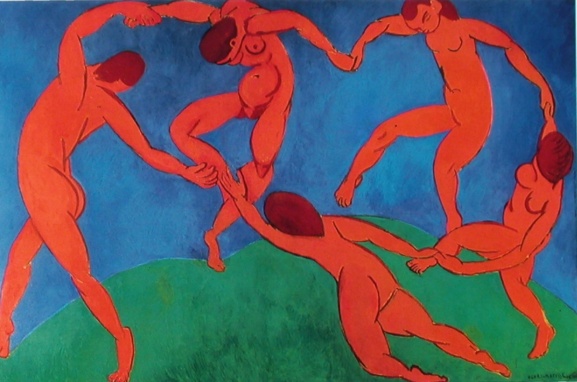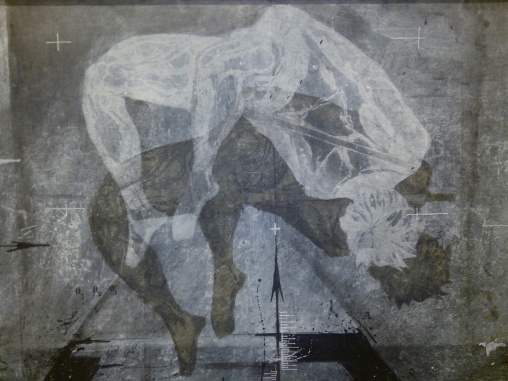What I like about dancing is that we do not need any external objects to dance. Only of our body. It is our material existence, our link between the inside and the outside. The sense organs are like open windows, and allow the body to communicate with the outside world, to receive information: sounds, smells … The body allows us to act, to react, according to what it receives.

In dance as in life, the body is our first instrument. As Martha Graham, an American dancer of the early 20th century, wrote, the body is a « sacred garment » : it is the first with which we are born, and the last we leave when we die. Whatever its limits, it is with our body that we dance. Even if only the fingers move. But is the body the only instrument of dance? To believe the magnificent shows of Philippe Découflé, or the company Momix for example, other types of instrument serve as accessories to the dancers: costumes, lights, effects made thanks to new technologies … The dancing human body is alternately sublimated, prolonged, metamorphosed, it mutates towards new forms, towards improbable movements. And these effects plunge the dancer as the spectator into a dream world. The spectacle of the body awakens in us a sensual and sensory memory.
Breathing, attention to sensations, are ways to synchronize body and mind. This synchronization gives a feeling of well-being that one seeks to find regularly, to maintain in the long term.
Should we say : « having a body » or « being a body » ?
This link to the body is important in all regions of the world, leading to the development of many traditional disciplines: sports, art, therapy, medicine … From triathlon to meditation, body painting to osteopathy, via the sauna , dance or psychomotricity, the approach perhaps scientific, artistic, philosophical. People around the world have wondered about this subject, have explored the human body, its material, its sensations, the synergy of its systems, its submission to natural laws, its capabilities, its borders.
According to the societies, the body is successively taboo, fascinating, demonized, attractive, repulsive, heavy, weak, powerful, empty, graceful, stiff, flexible … It is sometimes necessary to hide it, to better put forward the culture of the spirit, or on the contrary to work, sculpt, value.
But what makes a dancer is not just a body, with all its systems… There is something much more powerful, wider, invisible and made visible by the body. Corporeality, a way of being in the world, a presence, the essence of the human being, lead to this dance.
***
Body language is universal. Yet each body has its own language. Depending on his conditioning, his education, he develops faculties and gaps that evolve over time. By imitation, by modeling the movements of his peers without always being aware of it, the human being is shaped. Thus, he shapes his body and his mind. Then, each according to his experiences, his emotions, his sensitivity, will develop his own body language. But to become aware of this personal language is, I think, often difficult. I met many people who told me that they did not know how to dance at a party, an improvisation workshop, or other … I’ve been closed to dancing for a long time. » spontaneous. » Some have not been educated to « listen » to their bodies, others have followed a very academic education, and are uncomfortable with their own freedom of movement. Moreover, in many societies, the body is idealized – athletic body, dream body – resulting in many physical complexes in some people who will then walk, move differently: by huddling, lowering the body. head, walking the feet slightly inwards, bending the torso, destabilizing the balance of the skeleton. Dance brings those who practice it to feel more comfortable with their bodies, to be more fluid while moving in their daily lives. In other cultures, dance is an integral part of everyday life. We dance at sacred ceremonies, to mark the rites of passage, we practice the trance to heal … In this way, it seems to me that one develops a listening of his body more sharpened.
A light inside the body

Education in our Western societies values brain intelligence, and discredits that of the body. Worse, we are taught that the body does not even have intelligence. We must fight his reactions: symptoms, fever, impulses … For this, we learn techniques to silence the body: take medication, swallow his emotions or feelings, ignore his impulses. Some beliefs say that because the head, the symbol of reason, is placed at the top of the body, it is superior to it. This is a point of view. But we are not just a spirit, provided with a tool that serves him to move. From my point of view, I see the body as anchored on the ground while the head is pointing towards the sky. The intelligence of the head is therefore complementary to that of the body. And listening to your body is not just letting go when there is music, running or swimming. It is also listening to him when he speaks: tingling in the belly, or spasms, pounding in the head, feeling cold or hot, tremors … It’s his language, a language without words, a language of evils. To silence or ignore all these sensations when they are unpleasant is like putting earplugs, it does not solve the problem. If we become aware that our body can be a guide to listen, to consult, we will learn to know ourselves deeply, we will also gain self-confidence. We tend to intellectualize everything, to want to put words on everything, to define everything, to reason. And it happens that the reasoning is in contradiction with the emotions, which brings us into a spiral of tensions. But sometimes, we can just stop wagging, and listen to what’s going on inside, look at the little light in itself. It is not always necessary to react to what the body tells us, to try to understand with the head; taking the time to listen to it already leads us to accept it. It’s like listening to a music without words, you let yourself be overwhelmed by the sound without trying to put words immediately on what it evokes. Thus, by getting to know each other better and accepting each other, it becomes easier to dance.

By traveling around the world, going to meet different peoples, people who dance or not, we realize that we all have the same basis: we all have a human body in the same way. Does this seem obvious ? Yet, in this period of our small world, it seems to me that we forgot about this, that some people feel superior to others, and wars are declared in certain regions. But if we only focus on human beings, we would see how much we are doing! We dance differently, with different energy, but we move in the same way, with a bust, arms, legs, a head, emotions, even if they are different in size, or not the same energy. The wave and the ocean are they not made of the same wild water…? I forgot from who I had this picture in my head !
***
By definition, the body is our embodiment. As said above, He is our material existence. Thus, it is transformed, adapts to our way of life, and bears the scars of our journey in life. Growing and changing over the years, it also bears a memory of our history. Not only ours, but the ancestors we come from. This thought seems extraordinary to me! Even without knowing our ancestors, without knowing what they loved, what they did, who they were, we carry them within us. Martha Graham spoke of the memory of the blood, the liquid of life that has been passed on to us for many generations. « We carry thousands of years of blood and memory, » she wrote. Thus, our movements, our way of moving, does not belong only to us, this would be very reductive and very proud. If indeed we carry in us the memory of our ancestors, this memory inevitably influences our intuitive, unthinking behavior. The gestures, the words that come to us, without knowing why … Maybe the dance allows us to connect with the past, not only with our own past, but with the ancestral past. To connect to other entities. In some cultures, for example shamanic culture, the trance brings the shaman to communicate with ancestors, beings of the past. The body dance thus allows the mind to reconnect in what is deepest and unconscious.
***

Laisser un commentaire